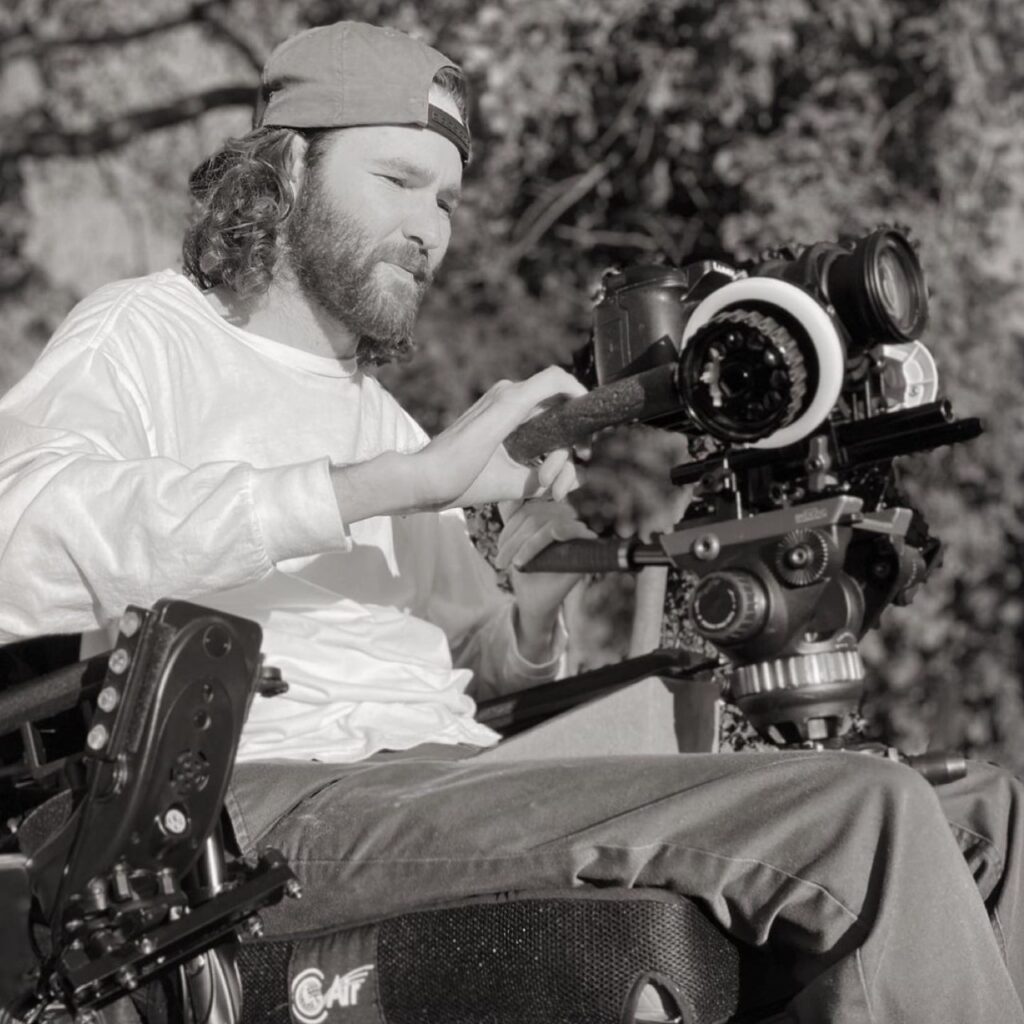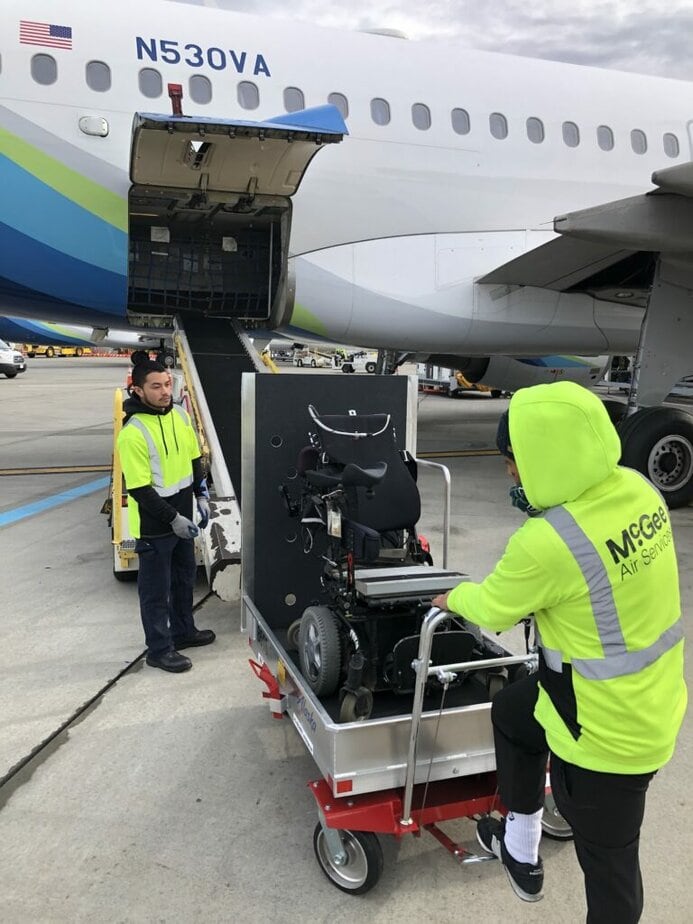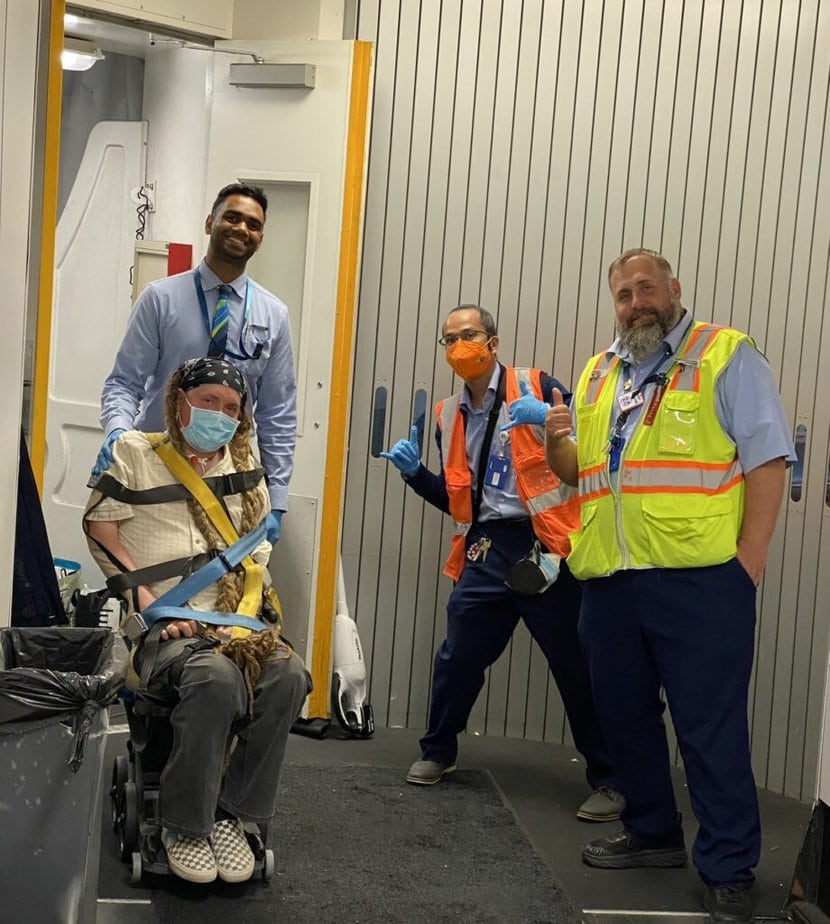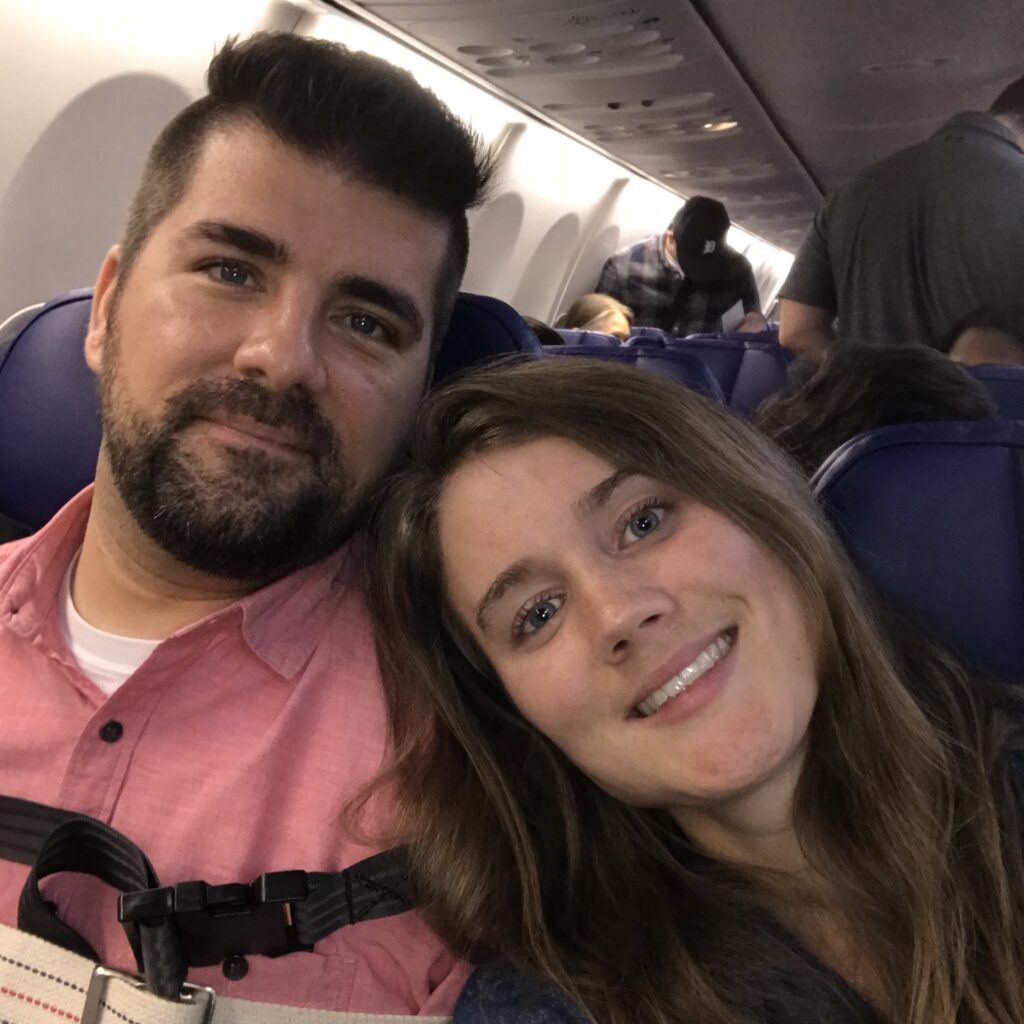You’ve seen the numbers and heard the horror stories. Reports from the Department of Transportation show that domestic airlines are still damaging or losing an average of 30 wheelchairs and scooters every day.
Factor in other potential issues — multiple awkward transfers in and out of rickety aisle chairs, long hours on uncomfortable aircraft seats and inaccessible in-flight lavatories — and traveling by air with a power wheelchair can seem hardly worth the risk. For former professional wakeboarder-turned-filmmaker and C5-6 quad Ben Leclair, it’s just another day at the office. “Before my accident, I was flying around the world 30 times a year,” he says, “so the plane wasn’t a stressful place for me.”
The extreme athlete from Quebec had just returned from zigzagging Europe to film a video with a few of his buddies when a training accident at a private wakeboarding park left him paralyzed. He was still an inpatient at a Montreal rehab 10 months after his injury when the opportunity arose to fly to Florida to get an award for the video. Leclair didn’t flinch. “I think the medical staff at the rehab center was a bit hesitant to let me fly, but I wasn’t.”

Since that first flight, Leclair has taken multiple international trips to judge and commentate for wakeboarding events in France and the U.K., while moonlighting as a spokesperson and brand ambassador for water sports company O’Neill and Wings for Life, a SCI research foundation. It was on one of those trips that he and a friend had the idea of documenting the air travel process for power chair users from start to finish.
I caught up with Leclair recently to swap stories and put together a few tips for power wheelchair users so we can maximize our ability to travel safely and independently while mitigating damage to the piece of equipment we rely on the most.
1. Know Your Equipment
The vast majority of damage to power wheelchairs occurs when they are being loaded and unloaded from the cargo bays beneath the planes. Most modern aircraft used for domestic air travel have smaller cargo-door hatches that make it difficult to load a power wheelchair in its standard upright position. This means baggage handlers must tip the device on its side. The more you can do to prevent that from happening, the more likely your device will emerge unscathed at your destination.

Learn how to modify your chair, whether with seating-system adjustments — like reclining the backrest on chairs that have that feature — or with tools if necessary. On his popular blog, WheelchairTravel.org, John Morris shares how he replaced two bolts on either side of the backrest with quick release pins to allow it to easily fold down over the seat. Identify all critical components and other items that could easily be damaged — joysticks, alternative drive controls, displays, cupholders, phone mounts, arm/leg/headrests, etc. — and prep them for easy removal prior to arriving at the airport. Attach clear assembly and disassembly instructions and do a practice run or two instructing the breakdown and reassembly of your device. This will make the process easier once you arrive on the day of your flight.
2. Do Your Homework
Once you’ve picked your destination and arranged accessible lodging and transportation well ahead of your arrival, it’s time to research your departure and arrival airports, as well as the airlines that fly in and out of them and any potential connecting stops. Leclair strongly advises flying nonstop whenever possible to avoid damage to your device. “The fewer opportunities you give the airlines to handle your equipment, the greater are your chances of having all of your stuff in one piece.”
You can research the cargo hold dimensions of the aircraft each airline uses for your potential routes to determine if your device will fit through the cargo door without being modified. Once you have selected your flights, be sure to include your power chair information and request special mobility assistance that you will need upon arrival (aisle chair, transfer team, etc.).
3. Communicate Clearly and Know Your Rights

Whether this is your first flight or your 1,000th, remember that you are the expert when it comes to your equipment, your body and your positioning. Advocating for yourself often means educating each person you encounter while booking your tickets, checking in, passing through security, waiting at the gate, transferring to the aisle chair and boarding the plane. Make sure to study the Air Carrier Access Act, because you never know when you may need to cite it — more on that below.
You can usually find information about each airport’s and airline’s disability assistance on the web, but it never hurts to call and talk to a real human whenever possible. The Transportation Security Administration’s TSA Cares helpline is a valuable resource that will answer questions about screening policies and procedures. Depending on staff availability, TSA can also provide a one-on-one guide who will meet you at ticketing and whisk you through security checkpoints.
The airlines can’t charge baggage fees for medical supplies and equipment, so bring as much gear as you can comfortably transport. For his first flight to Florida, Leclair brought an extra manual chair and zip-tied it upside-down on his shower chair just in case there were damages along the way. “We were like, ‘Shit, if they break one, I’ll have a second one,’” he says. Bringing an empty bag to store the removable chair parts, along with an extra ROHO cushion and pump and portable ramps as needed, are also good ideas.
“The fewer opportunities you give the airlines to handle your equipment, the greater are your chances of having all of your stuff in one piece.”
— Ben Leclair
4. Mitigate Damage
Prepare your wheelchair for transfer under the plane by removing those vulnerable parts discussed earlier in the article. Make sure to bring all mission-critical components like drive controls and seat cushions into the cabin with you to avoid having them misplaced or damaged.
You can use colored ribbon or tape to identify important aspects of the chair, including the levers that disengage the motors. Then have a laminated sheet attached to the chair explaining what each color does.
Trail and tech advocate Ian Mackay zip-ties a walkie-talkie to his chair in case handlers have questions while loading his device. “It gives you a direct line of communication with your chair in the cargo hold. This is particularly helpful when a baggage handler at your arrival location has a question,” he says.
If you are traveling with an entourage, strongly request that a member of your team accompany the baggage handlers as they bring the device down to the tarmac for the loading process. Having someone familiar with your equipment will guarantee it gets on the plane and isn’t mishandled. Later, implore the in-flight staff to call ahead to your destination to clear your helper(s) for similar treatment so staff can arrange to get them off the plane first.
5. Protect Your Body at All Costs
The minute you part ways with your power wheelchair, you are literally and figuratively in the hands of airport and airline personnel. This calls for another level of self-advocacy. In his video, Leclair is quick to point out that you are in charge of your transfer. “Don’t let anyone transfer you unless they are doing it safely,” he says. Aftermarket slings like the Comfort Carrier and ADAPTS sling can be helpful to avoid awkward transfers with inexperienced airport staff.
Placing a gel or ROHO cushion on the airline seat will help protect your skin on long flights, but remember that air cushions expand at altitude. Make adjustments accordingly. The Child Aviation Restraint System harness can help stabilize those with limited or no trunk-control in-flight and landing. Note that the CARES harness is only FAA-approved for children under 44 pounds. Adults will have to obtain an FAA exemption letter to be authorized to use one.

Bladder and bowel management is another issue to take into account due to the lack of accessible lavatories, especially on long trips. To avoid resorting to dehydration — a common tactic that can be problematic for those prone to UTIs — USA Low Point Wheelchair Rugby Team member Jeremy Hannaford brings a blanket to drape over his row so he can self-cath. “It helps other passengers mind their business while you handle yours,” he says. Leclair packs an empty 1-liter water bottle for incognito catheter draining purposes. “It’s a little surprise for the flight attendants when they find a yellow bottle somewhere.”
To avoid bowel issues, stick to foods you know your body processes well in the day or two leading up to a long flight. Adjust your bowel program timing if you need: Somewhere around 12 hours before your flight is often a good bet for doing your business to minimize the chance of accidents while traveling. Many colostomy users recommend irrigation prior to traveling to ensure an accident-free trip.
Upon your arrival, wait until you have confirmation that your wheelchair is returned to the jetway before allowing the transfer team to put you into the aisle chair, to avoid unnecessary time on its hard seat. Even if in-flight personnel threaten that TSA will “make [you] get off with their guns,” as world traveler Cory Lee recently experienced, waiting is your right under the Air Carrier Access Act.
Free Stuff
Both the CARES harness and ADAPTS sling are available for free through the Fly Safe Today program from accessible air travel nonprofit All Wheels Up.
Leclair curtailed his globetrotting ways because of the pandemic, but he’s looking forward to exploring the world again, despite the extra hurdles that come with traveling in his power wheelchair. “Inaccessibility is definitely slowing me down, but it won’t stop me,” he says.
He hopes his video will motivate others to return to traveling. “I know it looks really bad for a lot of people, but it is really fun to travel. Maybe this video can bridge the gap and show people that it’s not always hell.”
With a solid plan, clear communication and a little creativity, you too can set yourself up to navigate an inherently flawed system with success.
Support New MobilityWait! Before you wander off to other parts of the internet, please consider supporting New Mobility. For more than three decades, New Mobility has published groundbreaking content for active wheelchair users. We share practical advice from wheelchair users across the country, review life-changing technology and demand equity in healthcare, travel and all facets of life. But none of this is cheap, easy or profitable. Your support helps us give wheelchair users the resources to build a fulfilling life. |


Great article! As an avid traveler, I thought this article offered great advice. One thing I always request once I get to the gate is an opportunity to speak with the ramp supervisor, and give him/her an overview of my chair and the dos/don’ts of lifting it. Speaking of lifting, I wish more airports/airlines used the chair lifts shown in the first picture. One less opportunity for damage or injury.
One more thing I forgot to add…I’m a big proponent of using a transfer sling. Last year I purchased one, and I can say w/o hesitation that it is one of the best travel purchases I made. Transfers are much smoother, less painful, and staff seem to appreciate it as well.
Great article. My son is in a power chair C4/c5 and in addition to taking these steps, we also meet with the staff taking the chair before transferring to the aisle chair to board and emphasize how to take care of the chair and load properly.
Additionally, we tape index card with instructions on the chair to point out brakes and to manually push the chair and not use the power. Importantly, we remove every part from the chair that can be removed, as well— leg rests, goal post, seat cushion.
I get on the plane right before him and switch the cushion on the seat to his chair cushion. Doing it quite quickly so staff is unaware. 🙂 they definitely don’t like that too much.
Is the airline seat cushion removable? Which airlines do you use? I guess I always thought we would put the roho on top of their seat… this is great news!!
I’m 6’2 with an SCI, I don’t even fit on the dam airplane chair cause my legs are too long.
Still don’t get why they can’t have one seat at the front of the plane for a wheelchair person to roll Right on and then just lock the chair in place like they do on buses. Or have a removable chair to replace with a wheelchair. I quit traveling by plane now.